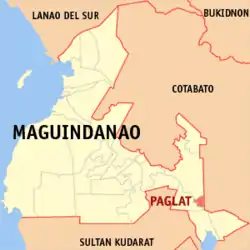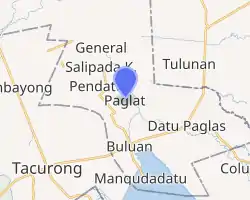Paglat
Paglat, officially the Municipality of Paglat (Maguindanaon: Ingud nu Paglat; Iranun: Inged a Paglat; Tagalog: Bayan ng Paglat), is a — municipality in the province of Maguindanao, Philippines. According to the 2015 census, it has a population of 15,920 people. [3]
Paglat | |
|---|---|
| Municipality of Paglat | |
 Map of Maguindanao with Paglat highlighted | |
OpenStreetMap 
| |
.svg.png.webp) Paglat Location within the Philippines | |
| Coordinates: 6°46′52″N 124°47′06″E | |
| Country | |
| Region | Bangsamoro Autonomous Region in Muslim Mindanao (BARMM) |
| Province | Maguindanao |
| District | 2nd District |
| Founded | July 19, 2001 |
| Barangays | 8 (see Barangays) |
| Government | |
| • Type | Sangguniang Bayan |
| • Mayor | Abdulkarim T. Langkuno |
| • Vice Mayor | Sagandingan M. Gumonsang |
| • Representative | Esmael G. Mangudadatu |
| • Electorate | 9,843 voters (2019) |
| Area | |
| • Total | 177.74 km2 (68.63 sq mi) |
| Elevation | 12 m (39 ft) |
| Highest elevation | 42 m (138 ft) |
| Lowest elevation | 5 m (16 ft) |
| Population | |
| • Total | 15,920 |
| • Density | 90/km2 (230/sq mi) |
| • Households | 2,455 |
| Economy | |
| • Income class | no value |
| • Poverty incidence | 58.60% (2015)[4] |
| • Revenue | ₱48,298,800.63 (2016) |
| Service provider | |
| • Electricity | Maguindanao Electric Cooperative |
| Time zone | UTC+8 (PST) |
| ZIP code | 9618 |
| PSGC | |
| IDD : area code | +63 (0)64 |
| Climate type | tropical climate |
| Native languages | Maguindanao Tagalog |
| Website | www |
History
It was created under Muslim Mindanao Autonomy Act No. 112 on July 19, 2001, carved out of the municipality of General S.K. Pendatun.[5]
The first appointed mayor was Bai Zulaika Pendatun-Langkuno, however, her appointment was recalled by then ARMM Governor Nur Misuari to give way for her cousin Datu Conte Mangelen, son of the then Congressman Datu Luminog Mangelen of Cotabato Province.
Geography
Barangays
Paglat is politically subdivided into 8 barangays.
- Campo
- Damakling
- Damalusay
- Kakal
- Poblacion/Paglat
- Salam
- Tual
- Upper Idtig
Climate
| Climate data for Paglat, Maguindanao | |||||||||||||
|---|---|---|---|---|---|---|---|---|---|---|---|---|---|
| Month | Jan | Feb | Mar | Apr | May | Jun | Jul | Aug | Sep | Oct | Nov | Dec | Year |
| Average high °C (°F) | 31 (88) |
31 (88) |
32 (90) |
32 (90) |
31 (88) |
30 (86) |
30 (86) |
30 (86) |
30 (86) |
30 (86) |
30 (86) |
31 (88) |
31 (87) |
| Average low °C (°F) | 23 (73) |
23 (73) |
23 (73) |
24 (75) |
24 (75) |
24 (75) |
24 (75) |
24 (75) |
24 (75) |
24 (75) |
24 (75) |
24 (75) |
24 (75) |
| Average precipitation mm (inches) | 64 (2.5) |
45 (1.8) |
59 (2.3) |
71 (2.8) |
140 (5.5) |
179 (7.0) |
192 (7.6) |
198 (7.8) |
163 (6.4) |
147 (5.8) |
113 (4.4) |
66 (2.6) |
1,437 (56.5) |
| Average rainy days | 12.2 | 10.3 | 12.7 | 15.7 | 26.0 | 27.4 | 28.1 | 28.2 | 26.0 | 26.7 | 22.9 | 16.6 | 252.8 |
| Source: Meteoblue (modeled/calculated data, not measured locally)[6] | |||||||||||||
Demographics
| Year | Pop. | ±% p.a. |
|---|---|---|
| 2007 | 23,432 | — |
| 2010 | 11,207 | −23.54% |
| 2015 | 15,920 | +6.91% |
| Source: Philippine Statistics Authority [3] [7] [8][9] | ||
References
- Municipality of Paglat | (DILG)
- "Province: Maguindanao". PSGC Interactive. Quezon City, Philippines: Philippine Statistics Authority. Retrieved 12 November 2016.
- Census of Population (2015). "ARMM – Autonomous Region in Muslim Mindanao". Total Population by Province, City, Municipality and Barangay. PSA. Retrieved 20 June 2016.
- https://psa.gov.ph/sites/default/files/City%20and%20Municipal-level%20Small%20Area%20Poverty%20Estimates_%202009%2C%202012%20and%202015_0.xlsx; publication date: 10 July 2019; publisher: Philippine Statistics Authority.
- "Muslim Mindanao Autonomy Act No. 112; An Act Creating Municipality of Paglat in the Province of Maguindanao, Authorizing the Municipality of Gen. S. K. Pendatun and Province of Maguindanao to Appropriate Funds Therefor" (PDF). Regional Legislative Assembly, Autonomous Region in Muslim Mindanao. Retrieved 27 January 2016.
- "Paglat, Maguindanao : Average Temperatures and Rainfall". Meteoblue. Retrieved 19 January 2019.
- Census of Population and Housing (2010). "ARMM – Autonomous Region in Muslim Mindanao". Total Population by Province, City, Municipality and Barangay. NSO. Retrieved 29 June 2016.
- Censuses of Population (1903–2007). "ARMM – Autonomous Region in Muslim Mindanao". Table 1. Population Enumerated in Various Censuses by Province/Highly Urbanized City: 1903 to 2007. NSO.
- "Province of Maguindanao". Municipality Population Data. Local Water Utilities Administration Research Division. Retrieved 17 December 2016.
- "Poverty incidence (PI):". Philippine Statistics Authority. Retrieved 28 December 2020.
- https://psa.gov.ph/sites/default/files/2006%20and%202009%20City%20and%20Municipal%20Level%20Poverty%20Estimates_0_1.pdf; publication date: 3 August 2012; publisher: Philippine Statistics Authority.
- https://psa.gov.ph/sites/default/files/2012%20Municipal%20and%20City%20Level%20Poverty%20Estima7tes%20Publication%20%281%29.pdf; publication date: 31 May 2016; publisher: Philippine Statistics Authority.
- https://psa.gov.ph/sites/default/files/City%20and%20Municipal-level%20Small%20Area%20Poverty%20Estimates_%202009%2C%202012%20and%202015_0.xlsx; publication date: 10 July 2019; publisher: Philippine Statistics Authority.
External links
- Paglat Profile at PhilAtlas.com
- MMA Act No. 112: An Act Creating Municipality of Paglas in the Province of Maguindanao
- Philippine Standard Geographic Code
- Philippine Census Information
- Local Governance Performance Management System
This article is issued from Wikipedia. The text is licensed under Creative Commons - Attribution - Sharealike. Additional terms may apply for the media files.
